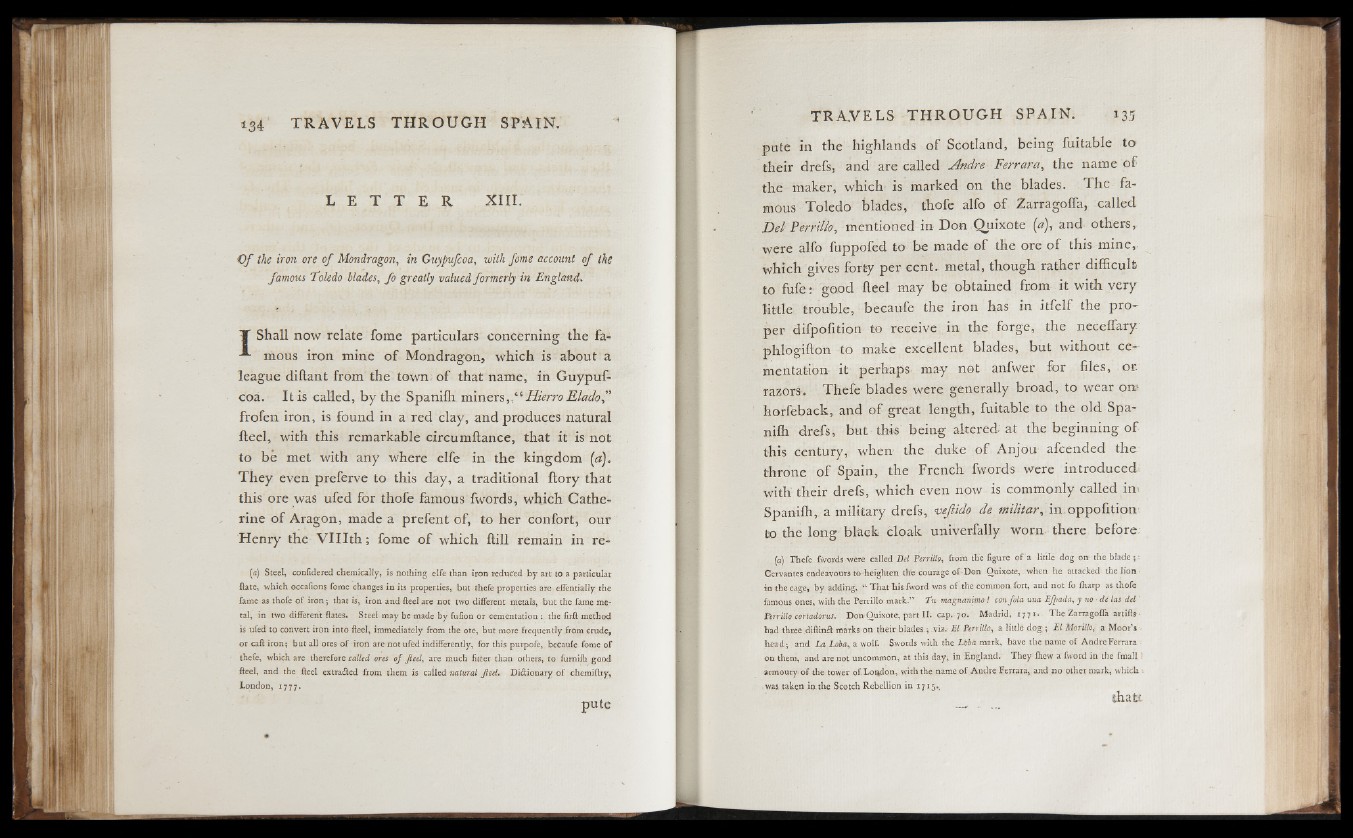
L E T T E R X III.
O f the iron ore o f Mondragon, in Guypufcoa, with fome account o f the
famous Toledo blades, fo greatly valued formerly in England»
T Shall now relate fome particulars concerning the fa-
-*• mous iron mine o f Mondragon, which is about a
league diftant from the town of that name, in Guypufcoa.
It is called, by the Spaniih miners,,“ Hierro Eladof
frofen iron, is found in a red clay, and produces natural
iteel, with this remarkable circumftance, that it is not
to be met with any where elfe in the kingdom (a).
They even preferve to this day, a traditional itory that
this ore was ufed for thofe famous fwords, which Catherine
of Aragon, made a prefent of, to her confort, our
Henry the V U I th ; fome o f which itill remain in re-
(a) Steel, confidered chemically, is nothing elfe than iron reduced by art to a particular
hate, which occafions fome changes in its properties, but thefe properties are elfentially the
fame as thofe o f iron; that is, iron and fteel are not two different metals, but the fame metal,
in two different hates. Steel may be made by fuiion or cementation the firh-method
is ufed to convert iron into heel, immediately from the ore, but more frequently from crude,
or cah iron; but all ores o f iron are not ufed indifferently, for this purpofe, becaufe fome o f
thefe, which are therefore called ores o f fe e l, are much fitter than others, to furnifh good
heel, and the heel extra&ed from them is called natural fled, Diitionary o f chemihry,
London, 1777.
pute
pute in the highlands of Scotland, being fuitable to
their drefs, and are called Andre Ferrara, the name of
the maker, which is marked on the blades. The famous
Toledo blades, thofe alfo of Zarragoifa, called
Del Perrillo, mentioned in Don Quixote (a), and- others,
were alfo fuppofed to be made of the ore o f this mine,
which gives forty per cent, metal, though rather difficult
to fufe: good iteel may be obtained from it with very
little trouble, beeaufe the iron has in itfelf the pro-
per difpoiition to receive in the forge, the neceifary.
phlogiiton to make excellent blades, but without cementation
it perhaps ma-y not anfwer for files, or.
razors. Thefe blades were generally broad, to wear o®
horfeback, and of great length, fuitable to the old Spaniih
drefs, but this being altered-at the beginning o f
this century, when the duke o f Anjou afcended the
throne of Spain, the French fwords were introduced,
with their drefs, which even now is commonly called in*
Spaniih,. a military drefs, vefiido de militar, in.oppofition
to the long black cloak univerfally worn, there before.
(4) Thefe fWords were called Del Perrillo, from the figure o f a little dog on' the blade;;
Cervantes endeavours to'heighten the courage of-Don Quixote, when he attacked the lion 1
in the cage, by adding, “ That his fword was o f the common fort, and not fo fharp as thofe
famous ones, with the Perrillo mark." Tit magnanimo! confola una Efpada, y no ■ de las de l'
Perrillo cortadorus. Don Quixote, part II. cap.- 70. Madrid, r 7 7 1 ■ The Zarragoila artrfls
had three diftina marks on their blades ; via. El Perrillo, a littld dog-,; El Morillo, a Moor’s
head.; and La.Loha, a wolf. Swords with the Lbbd mark, have the name of AndreFerrara
on them, and are not uncommon, at this day, in England. They ihew a fword in the fmall'
armoury.of the tower of.Lotion, with the name of Andre Ferrara, and no other mark, which .
was taken in. the Scotch Rebellion in 1715.,
thati